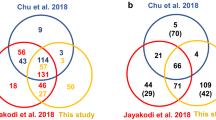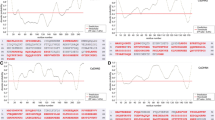Abstract
The dehydrins (DHN) are a family of late embryo abundant (LEA D-11) proteins, which accumulate during the late stage of seed development or under low temperature or water deficient conditions. They are believed to play a protective role in freezing and drought tolerance. The dehydrin genes exist as multi-gene families. Here, we have identified 9 unique dehydrin genes from Korean ginseng (Panax ginseng C.A. Meyer), a typical medicinal plant Among these,PgDhn1 andPgDhn2 encode for YSK3- and KS-type dehydrins, respectively, and are very abundant. Gene expression analyses revealed that the majority of thePgDhn gene transcripts are detected under cold, as well as dehydration conditions. The exceptions arePgDhn5 and PgDhn9—the former being unresponsive to cold treatment, and the latter exhibiting only seed-specific expression. We also identified an alternative transcript of thePgDhn2 gene that harbors an intron in its 3’-untranslated region. Our results may prove useful in further studies ofDhn genes, including investigations into the mechanisms underlying gene expression, the nature of their variations, and their physiological functions.
Similar content being viewed by others
Literature Cited
Alsheikh MK, Heyen BJ, Randall SK (2003) Ion binding properties of the dehydrin ERD14 are dependent upon phosphorylation. J Biol Chem278: 40882–40889
Bray EA (1993) Molecular response to water deficit. Plant Physiol103: 1035–1040
Bray EA (2002) Classification of genes differentially expressed during water-deficit stress inArabidopsis thaliana: An analysis using microarray and differential expression data. Ann Bot89: 803–811
Campbell SA, Close TJ (1997) Dehydrins: Genes, proteins, and associations with phenotypic traits. New Phytol137: 61–74
Choi DW, Close TJ (2000) A newly identified barley gene,Dhn12 encoding a YSK2 DHN, is located on chromosome 6H and has embryo-specific expression. Theor Appl Genet100: 1274–1278
Choi DW, Jung JD, Ha YI, Park HW, In DS, Chung HJ, Liu JR (2005) Analysis of transcripts in methyl jasmonate-treated ginseng hairy roots to identify genes involved in the biosynthesis of ginsenosides and other secondary metabolites. Plant Cell Rep23: 557–566
Choi DW, Zhu B, Close TJ (1999) The barley (Hordeum vulgare L.) dehydrin multigene family: Sequences, allelic types, chromosome assignments, and expression characteristics of 11Dhn genes of cv. Dicktoo. Theor Appl Genet98: 1234–1247
Chung HJ, Park JY, Cho IS, Hur CG, Choi DW, Liu JR (2004) Isolation and characterization of Panaxginseng 14-3-3 gene family47: 167–173
Close TJ (1996) Dehydrins: Emergence of a biochemical role of a family of plant dehydration proteins. Physiol Plant97: 795–803
Close TJ (1997) Dehydrins: A commonality in the response of plants to dehydration and low temperature. Physiol Plant100: 291–296
Danyluk J, Perron A, Houde M, Limin A, Fowler B, Benhamou N, Sarhan F (1998) Accumulation of an acidic dehydrin in the vicinity of the plasma membrane during cold acclimation of wheat. Plant Cell10: 623–638
Garay-Arroyo A, Colmenero-Flores JM, Garciarrubio A, Covarrubias AA (2000) Highly hydrophilic proteins in prokaryotes and eukaryotes are common during conditions of water deficit. J Biol Chem275: 5668–5674
Hara M, Terashima S, Fukaya T, Kuboi T (2003) Enhancement of cold tolerance and inhibition of lipid peroxidation by citrus dehydrin in transgenic tobacco. Planta217: 290–298
Heyen BJ, Alsheikh MK, Smith EA, Torvik CF, Seals DF, Randall SK (2002) The calcium binding activity of a vacuoleassociated, dehydrin-like protein is regulated by phosphorylation. Plant Physiol130: 675–687
Ingram J, Bartels D (1996) The molecular basis of dehydration tolerance in plants. Annu Rev Plant Physiol Plant Mol Biol47: 377–403
Jung JD, Park HW, Hahn Y, Hur CG, In DS, Chung HJ, Liu JR, Choi DW (2003) Discovery of genes for ginsenoside biosynthesis by analysis of ginseng expressed sequence tags. Plant Cell Rep22: 224–230
Kim SJ, Jeong DH, An G, Kim SR (2005) Characterization of a drought-responsive gene,OsTPS1, identified by the TDNA gene-trap system in rice. J Plant Biol48: 371–379
Koag MC, Fenton RD, Wilkens S, Close TJ (2003) The binding of maize DHN1 to lipid vesicles: Gain of structure and lipid specificity. Plant Physiol131: 309–316
Kruger C, Berkowitz O, Stephan UW, Hell R (2002) A metal-binding member of the late embryogenesis abundant protein family transports iron in the phloem ofRicinus communis L. J Biol Chem277: 25062–25069
Lang V, Robertson M, Chandler PM (1998) Allelic variation in the dehydrin gene family of ‘Himalaya’ barley (Hordeum vulgare L.). Theor Appl Genet96: 1193–1199
Mignone F, Gissi C, Liuni S, Pesole G (2002) Untranslated regions of mRNAs. Genome Biol3: 0004.1–0004.10
Murray MG, Thompson WF (1980) Rapid isolation of high molecular weight plant DNA. Nucl Acids Res8: 4321–4326
Nylander M, Svensson J, Palva ET, Welin BV (2001) Stressinduced accumulation and tissue-specific localization of dehydrins inArabidopsis thaliana. Plant Mol Biol45: 263–279
Rodriguez EM, Svensson J, Malatrasi M, Choi DW, Close TJ (2005) BarleyDhnl3 encodes a KS-type dehydrin with constitutive and stress responsive expression. Theor Appl Genet110: 852–858
Seki M, Narusaka M, Abe H, Kasuga M, Yamaguchi-Shinozaki K, Carninci P, Hayashizaki Y, Shinozaki K (2001) Monitoring the expression pattern of 1300Arabidopsis genes under drought and cold stresses by using a fulllength cDNA microarray. Plant Cell13: 61–72
Shinozaki K, Yamaguchi-Shinozaki K (2000) Molecular response to dehydration and low temperature: Difference and cross-talk between two stress signaling pathways. Curr Opin Plant Biol2: 217–223
Verwoerd TC, Dekker BM, Hoekema A (1989) A small-scale procedure for the rapid isolation of plant RNAs. Nucl Acids Res17: 2362
Zhu B, Choi DW, Fenton R, Close TJ (2000) Expression of the barley dehydrin multigene family and the development of freezing tolerance. Mol Gen Genet264: 145–153
Author information
Authors and Affiliations
Corresponding author
Rights and permissions
About this article
Cite this article
Ha, YI., Lim, JM., Ko, S.M. et al. Sequence variability and expression characteristics of the ginseng (Panax ginseng C.A. Meyer) dehydrin gene family. J. Plant Biol. 49, 205–211 (2006). https://doi.org/10.1007/BF03030534
Received:
Accepted:
Issue Date:
DOI: https://doi.org/10.1007/BF03030534




